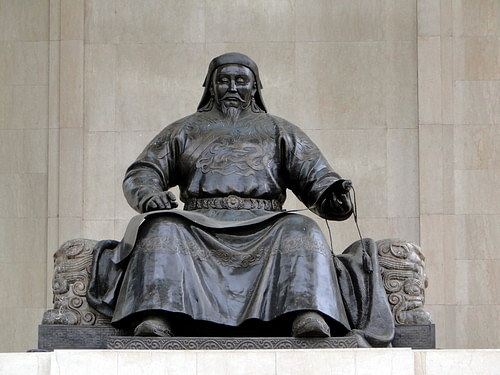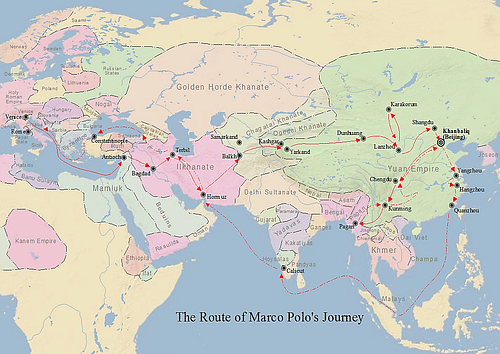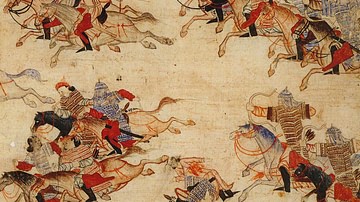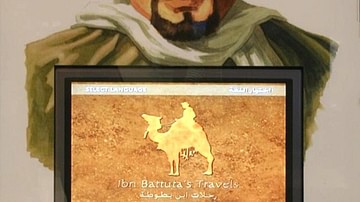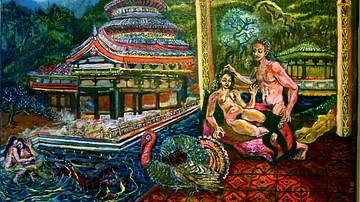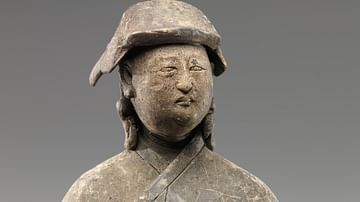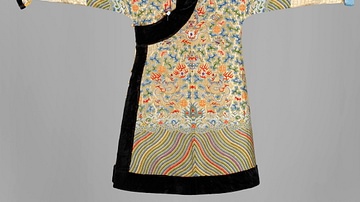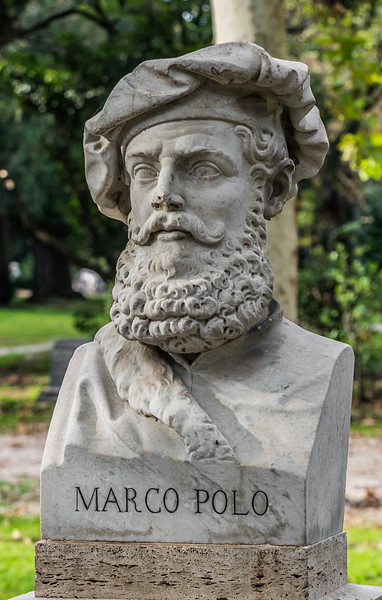
Marco Polo (1254-1324 CE) was a Venetian merchant and explorer who travelled to China and served the Mongol ruler Kublai Khan (l. 1214-1294 CE) between c. 1275 and 1292 CE. Polo's adventures are recounted in his own writings, The Travels, where he describes the peoples, places, and customs of the East, including the fabulous court of the Khan. The work caused a sensation and was one of the principal factors in creating a lasting image in European minds that China was a fabulous land of wealth and exotica, almost too fantastic to be believed. Even if doubts remain as to just where he travelled to and what he saw with his own eyes, Marco Polo continues to enjoy a reputation as one of the world's greatest ever explorers and his work provides invaluable insights into Mongol rule and Asia in general in the late 13th century CE.
The Court of Kublai Khan
Marco Polo was born into a wealthy Venetian merchant family in 1254 CE; his mother died shortly after giving birth to Marco. In 1271 CE, then aged just 17, Marco accompanied his father and uncle, Niccoló and Maffeo, on what was the elder men's second journey to East Asia, visiting the court of the Mongol leader Kublai Khan in China. The group was accompanied by two friars, eager to travel as missionaries but, after the hardships of the journey, they only got as far as Armenia before turning back. The Polos travelled on by land over the well-established and often ancient trade routes, including the Silk Road(s) that crossed the plains, mountains, and deserts that stretched from Europe to Asia. They went through Persia and the Ilkhan Empire, Samarkand and Turkestan, and then through the Chagatai Khanate. Sometimes they stopped at certain places for months on end while they recovered from fatigue, illness, or awaited fellow travellers to group and form an escorted caravan that might better withstand the dangers of travelling through wild country plagued by bandits. In 1275 CE, after a three-and-a-half-year trek, the Polos finally reached the court of the Khan at his summer capital of Shangdu (Xanadu).
The Mongol leader Kublai Khan ruled China as emperor of the Yuan dynasty (1276-1368 CE) under the reign name Shizu. Kublai, grandson of Chinggis Khan (aka Genghis Khan, l. 1162- 1227 CE), created the largest empire the world had ever seen, with Mongol rule extending from the Caspian Sea to the Korean peninsula. Kublai's permanent capital was Cambaluc (aka Khanbalikh, Tatu or Daidu) on the site of modern Beijing (which would be made the capital of China in 1421 CE) and his court was famous for its splendour. The Khan was known as a keen supporter of literature, he himself favoured Buddhism but he permitted all religions to be practised, and he embraced Chinese culture, unlike his predecessors. In short, the Khan was an ideal host to welcome such a traveller as Marco Polo.
The young Venetian would be suitably admiring in his description of the Khan:
Kublai, who is styled grand khan, or lord, is of the middle stature, that is, neither tall nor short; his limbs are well formed, and in his whole figure there is a just proportion. His complexion is fair, and occasionally suffused with red, like the bright tint of the rose, which adds much grace to his countenance. His eyes are black and handsome, his nose is well shaped and prominent (112).
The admiration must have been mutual as Marco was appointed a permanent and roving envoy of the Khan, a move in keeping with the Mongol ruler's policy of not using Chinese officials when possible. It seems that, just as Marco would wow Europe with his tales of the East later in life, so, too, he was destined to travel to the further parts of the Mongol Empire and then return to the Khan and inform him of the peoples and customs he had encountered. He learnt local languages, took extensive notes in his role as the Khan's envoy, and was perhaps even made deputy governor of Yang Chow, a post he held for three years (although some scholars maintain he resided there in some other capacity).
Return & Imprisonment
Marco, along with his father and uncle, finally left China in 1292 CE after staying an incredible 17 years with the Khan, who only very reluctantly let them leave. The excuse was Marco would escort a princess sent by the Khan to marry a fellow Mongol ruler, Arghun, in Persia. The Khan gave them passports of safe conduct through his empire and that of his vassal states, as well as a parting gift of magnificent jewels. The Polos eventually returned home to Venice in 1295 CE - the year after Kublai Khan died, sailing an epic voyage that went via Vietnam, Sumatra, Sri Lanka, and the Persian Gulf. They had been away from Venice for 24 years and had understandable difficulty convincing their fellow citizens of who they were. The fabulous jewels they had brought back helped a great deal and even gave the Polos the nickname Millioni, although some sources claim the name derived from Marco constantly repeating the vast wealth he had seen in China.
Marco's loyalties to his home city remained strong, and the adventurer fought in the war against Venice's long-time rival Genoa, serving as a sea captain. Marco was wounded and captured by the Genoese in 1296 or 1298 CE. He was then imprisoned, but at least this gave him the opportunity to put down in writing his epic adventures in Asia. Well, actually a fellow inmate did the writing, one Rusticien of Pisa (aka Rustichello or Rustigielo), who followed Marco's dictation based on his private notes made in Asia, which are referred to several times in the text itself.
Released from prison, Marco Polo lived a quiet life thereafter. He married and had three daughters. The adventurer died, aged 70, in 1324 CE and was buried near the Church of St. Lorenzo in Venice. A legend did the rounds that on his deathbed the great explorer was asked to confess that his book was all tall tales. Marco responded that he had not described even half of the wonders that he had seen.
Reaction, Controversy & Influence
The finished work of Marco Polos' adventures, titled simply Il milione ('The Million') is often given the title of The Travels of Marco Polo or Travels (Description of the World) in English. The manuscript was circulated c. 1298 CE and immediately caused a sensation. This window into the impossibly distant and exotic world of the East was irresistible. Fantastic tales of impossibly strange peoples and customs captivated medieval Europe as several translations of the original French manuscript were made. There were doubters, too, that Marco was prone to exaggeration and literary license and perhaps he had never even been to all the places he claimed he had. In fairness, the prologue of the book does state right at the start that it is an account of both what Marco saw himself and what others related to him secondhand, including folklore and hearsay.
Apart from satisfying people's curiosity about what lay beyond the horizon in distant lands and, no doubt, inspiring some to follow in his footsteps, Marco Polo's work is also an invaluable historical record of people, places, and cultural practices, even if it, like any other historical text, must be treated with caution. There are certainly some striking omissions in the work. Scholars have noted he does not mention tea or foot binding but these may not have been practised by the Mongols as they were by the Chinese. Neither does he mention the Great Wall of China but the sections he might have seen were in disrepair at that time (the wall had not, after all, stopped the Mongols) and it was only refortified during the later Ming dynasty. Other omissions, more difficult to explain, include Chinese writing, woodblock printing, and the use of chopsticks. On the other hand, Marco does make mention of unique Chinese practices at that time unknown in Europe such as the circulation of paper money and the use of coal as a household fuel. It is also true that many original points of doubt on some of the book's contents, especially on place names and geographical locations, have since been corroborated by Chinese sources and archaeology.
Besides stirring wonder and scepticism in equal measure, Marco's work also had a few unintentional consequences. For example, he corrupted the name of the semi-nomadic Khitan tribes (who were then pressing hard at China's northern borders) to 'Cathay' and this name stuck in Europe for centuries to refer first to northern China only and then later the whole of that country.
While China would pursue a period of relative isolationism following the death of Kublai Khan and the rise of the Ming Dynasty, the next great world traveller who bridged the gap between East and West would be Zheng He (1371-1433 CE), the Chinese admiral who travelled as far as the Persian Gulf and East Africa during his seven epic sea voyages. Then, in 1492 CE the world opened up a whole lot more when one particular reader of The Travels was inspired by the tales of fabulous wealth in the East to attempt to find a route that went westwards across uncharted waters and so reach Asia by sea: one Christopher Columbus.
The Travels
Here follows a selection of passages from The Travels (all taken from the Konemann edition). Not at all lacking confidence in the value of his work, Marco begins his book with the following swagger:
Ye emperors, kings, dukes, marquises, earls, and knights, and all other people desirous of knowing the diversities of the races of mankind as well as the diversities of kingdoms, provinces, and regions of all parts of the East, read through this book… (9)
Passing through Iraq on his way to distant China, Balsara and Baldach (Babylon) get a mention:
…a city name Balsara, in the vicinity of which are groves of palm-trees producing the best dates in the world. In Baldach there is a manufacture of silks wrought with gold, and also of damasks, as well so of velvets ornamented with the figures of birds and beasts. Almost all the pearls brought to Europe from India have undergone the process of boring, at this place. (29)
On the nomadic Tatars of central Asia:
Their huts or tents are formed of rods covered with felt, and being exactly round, and nicely put together, they can gather them into one bundle, and make them up as packages, which they carry along with them in their migrations, upon a sort of car with four wheels. When they have occasion to set them up again, they always make the entrance face to the south. (81)
On Kublai Khan's love of trees:
Not far from the palace, on the northern side, and about a bow-shot distance from the surrounding wall, is an artificial mount of earth, the height of which is full a hundred paces, and the circuit at the base about a mile. It is clothed with the most beautiful evergreen trees, for whenever his majesty receives information of a handsome tree growing in any place, he causes it to be dug up, with all the roots and the earth about them, and however large and heavy it may be, he has it transported by means of elephants to this mount, and adds it to the verdant collection. From this perpetual verdure it has acquired the appellation of the Green Mount. (118)
The mystery of paper currency is described for the first time to European audiences:
The coinage of this paper money is authenticated with as much form and ceremony as if it were actually of pure gold or silver; for to each note a number of officers, specially appointed, not only subscribe their names, but affix their signets also; and when this has been regularly done by the whole of them, the principle officer…having dipped into vermilion the royal seal committed to his custody, stamps with it the piece of paper, so that the form of the seal tinged with vermilion remains impressed upon it, by which it receives full authenticity as current money, and the act of counterfeiting it is punished as a capital offence. (143)
On the efficient Mongol postal system and stations for travellers:
Upon every great high road, at the distance of twenty-five or thirty miles, accordingly as the towns happen to be situated, there are stations, with houses of accommodation for travellers, called yamb or post-houses. These are large and handsome buildings, having several well-furnished apartments, hung with silk, and provided with everything suitable to persons of rank…At each station four hundred good horses are kept in constant readiness, in order that all messengers going and coming upon the business of the grand khan, and all ambassadors, may have relays, and, leaving their jaded horses, be supplied with fresh ones…In his dominions no fewer than two hundred thousand horses are thus employed in the department of the post, and ten thousand buildings, with suitable furniture are kept up. (146-7)
On the heady rice wine of China:
The greater part of the inhabitants of the province of Cathay drink a sort of wine made from rice mixed with a variety of spices and drugs. This beverage, or wine as it may be termed, is so good and well flavoured that they do not wish for better. It is clear, bright, and pleasant to the taste, and being made very hot, has the quality of inebriating sooner than any other. (153)
Finally, on the manufacture of indigo dye in the Indian city of Koulam, visited on Marco Polo's return voyage to Venice:
Indigo also, of excellent quality and in large quantities is made here. They procure it from an herbaceous plant, which is taken up by the roots and put into tubs of water, where it is suffered to remain till it rots; when they press out the juice. This, upon being exposed to the sun, and evaporated, leaves a kind of paste, which is cut into small pieces of the form in which we see it brought to use. (274)
